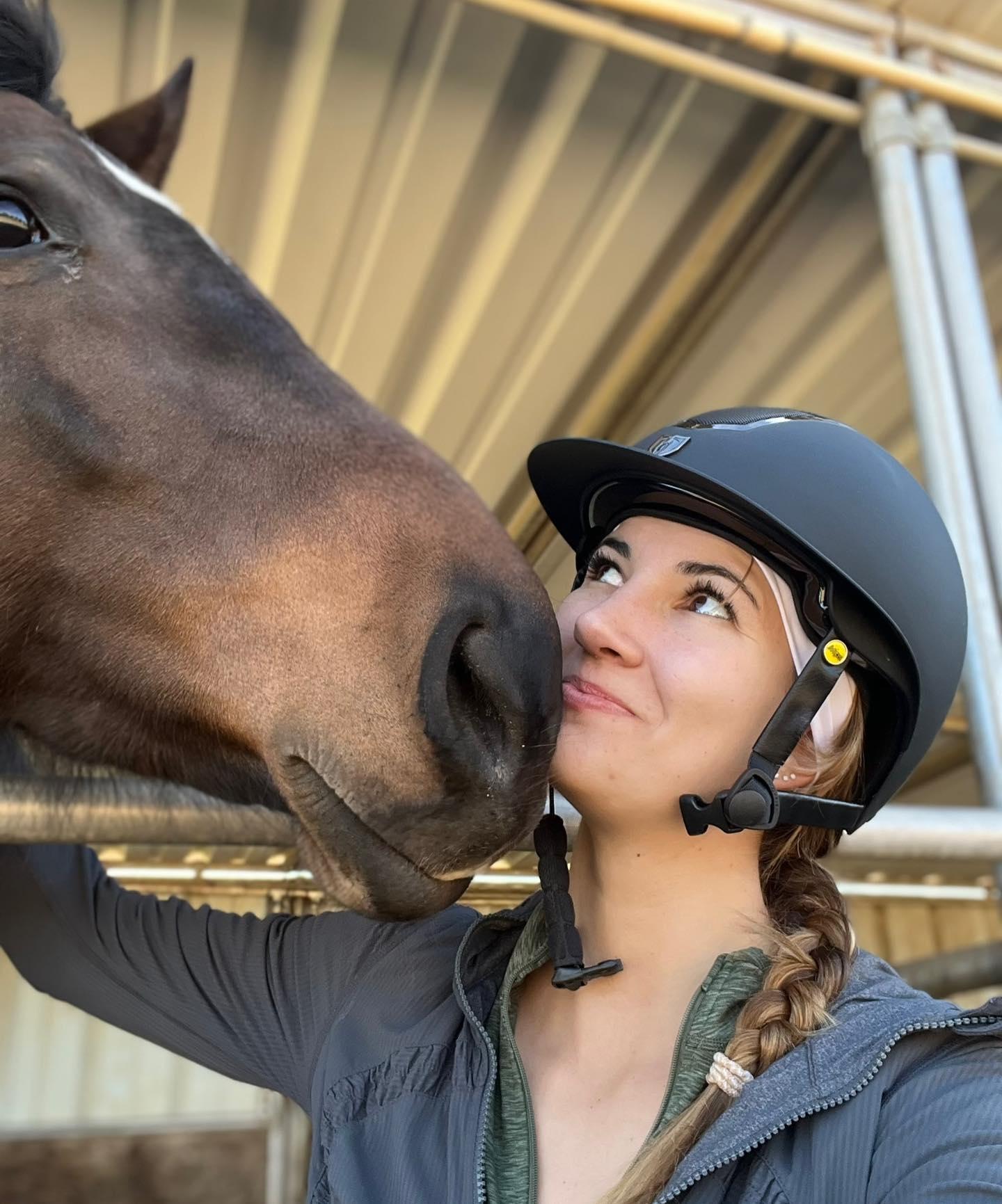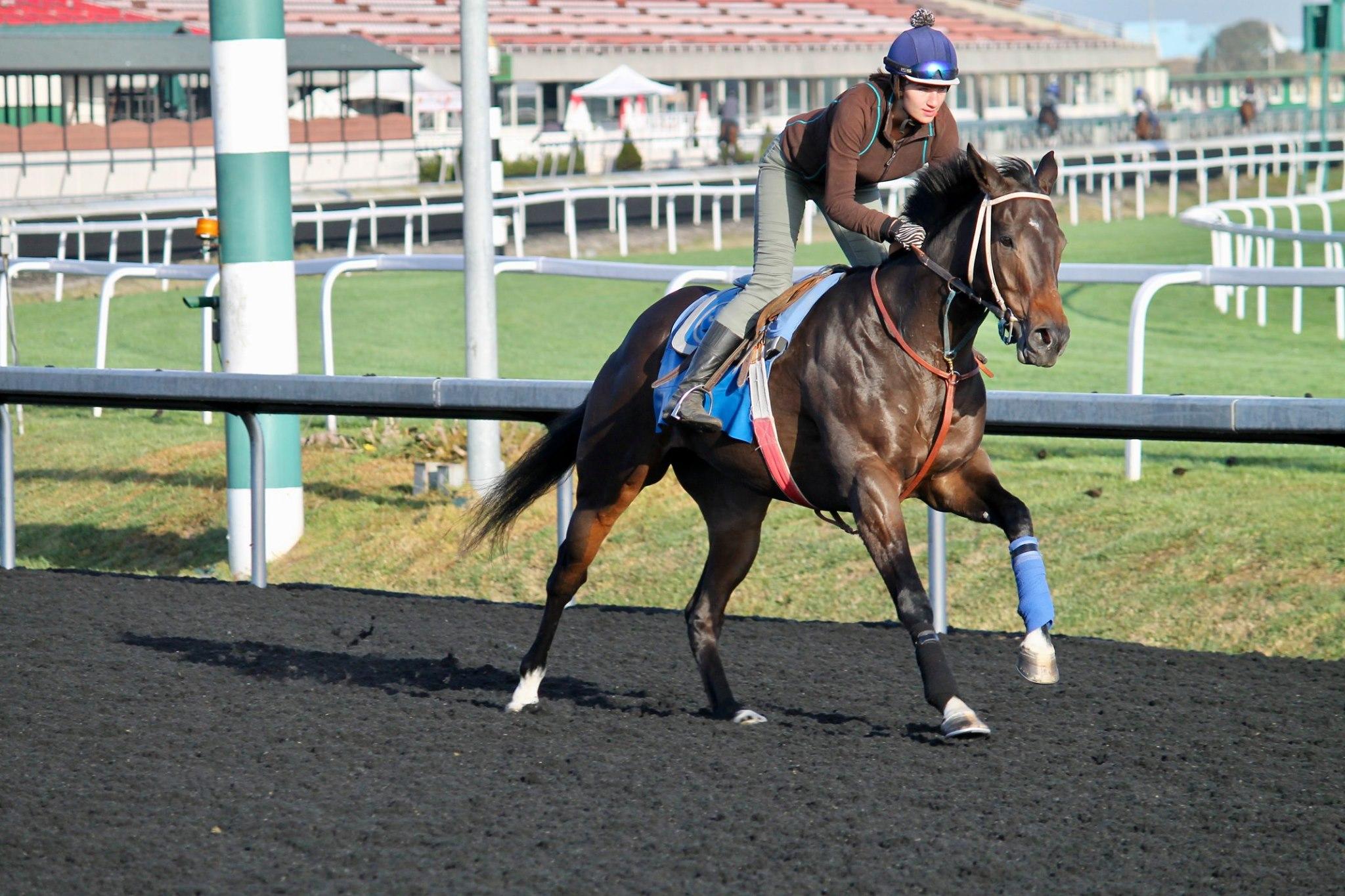
Barn Aisle Chats: Thoroughbred Aftercare With Emma
In the series Barn Aisle Chats, we meet equestrians from all walks of life and disciplines. Today, we chat with Emma about life at the track.
Last month, we spoke to Erin about OTTB rehabilitation. During the chat, she introduced me to Emma, who she described as her “OTTB partner in crime.” Today, we talk with Emma about her love for Thoroughbreds and her job as Aftercare Liaison at Golden Gate Fields.
Amanda: Hi Emma! Welcome to Horse Nation. So tell me about how you first fell in love with horses.
Emma: I remember being a toddler and gravitating toward horses everywhere I went. I’m not from a “horsey” family, but my dad used to take me to a local farm when I was little. I would feed celery and carrots to the horses; they were always my favorite animals. When I was around six years old, I had my first riding lesson on a lead line with Erin. I was immediately hooked. I never passed up an opportunity to ride — even bucky ponies or massive warmbloods. My foundation was in dressage, which really helped when I started jumping a few years later. I always wanted to go faster, jump higher, and ride more difficult horses.
A: You said your foundation was in dressage and then you moved on to jumping. When, how and what precipitated your becoming an exercise rider at the track?
E: I read “Seabiscuit” as a kid and I was always enamored by Thoroughbreds in general. Their intelligence and charisma captivated me. My first horse, Ross, was an OTTB. He sadly passed away last year at the age of 26, after 15 good years together. He really made me fall in love with the breed.
So I knew I wanted to get on a racehorse. First, I started grooming at the track, and then I started learning to gallop not long after. It was incredibly difficult and discouraging at times; I probably put on 15 pounds of solid muscle in the first month. It required much more strength than any other kind of riding I had done. Naively, I thought that being an exercise rider was all about going fast. It isn’t! Most of my job is trying to slow down an overly eager horse. They don’t just run around at a full gallop every day. The trainer who taught me to gallop started his own babies, so I helped him get them ready to go to the track. Those babies and I got fit together.
A: Describe a typical day being an exercise rider?
E: I usually show up around 6:15 AM. I have three barns that I primarily ride for, and on a light day, I might ride eight horses. If I’m busy, I can fit up to 16 in a morning. The trainer will write a list on the whiteboard with what each horse is supposed to do that morning. Some will jog (trot), some will gallop, some will go a shorter distance, some longer. Most of the horses I ride have known me since they were two years old, so we know each other well.
Generally, older, more experienced horses will exercise earlier in the morning when there is more traffic and commotion. Babies and greener horses will go out later, when the track is quieter.
A: And you are the aftercare liaison for Golden Gate Fields? What does that entail?
E: My job is to assist with the placement of retiring racehorses. Trainers and/or owners will often approach me and say, “Hey, I have a big, beautiful mare who just isn’t fast enough. Can you help me list her for sale?” Then I will take a look at the horse, take pictures and help them list their horse on CANTER and vet potential homes.
Sometimes they will ask me to help directly place the horse with either a private adopter or an aftercare charity. I will reach out to my personal connections and the local Thoroughbred organizations to find the perfect place for that particular horse. If a horse is in need of some rehab or time off, oftentimes a TAA-accredited charity is the best option. If a horse has severe behavioral or physical issues and cannot safely be a performance horse or riding horse, sometimes a sanctuary is the best place for them. Some horses that cannot be ridden thrive as on-the-ground therapy horses. Each horse is an individual; there is no right answer for all horses.
Once a home is found, I will usually help coordinate transportation and work out logistics.
I check up on the horses that are placed through me periodically to make sure they are doing well in their new environments. For horses that are placed locally, I will often offer to put the first post-track ride on them if their new owner would like me to. I have done that a handful of times.
A: Are aftercare liaisons common at tracks?
E: Aftercare Liaison, as the name stands, was thought up at GGF itself.
With social media the way it is now, it is both harder and easier to keep track of horses. Twenty years ago, horses were mostly sold locally to “Farmer Joe down the road for his daughter,” kept as riding horses or bred. Now people can sell to anyone from anywhere who can pretend to be anyone from anywhere. Owners want assurance that their horses are ending up in good places and many tracks (all Stronach tracks) have anti-slaughter policies. Honestly, any trainer caught sending a horse to slaughter would not be welcome there again.
A: What do you wish owners and trainers understood about successfully getting a horse adopted after retirement?
E: I’m actually very proud of my local owners and trainers! With very, very few exceptions, they have been great at working with me. I wish everyone understood that often, we are setting these horses up for success or failure based on the way we train them and when or how they retire. Even owners who intend on keeping the horse for life should keep this in mind: circumstances change. Get your babies started at a good, reputable farm and send them to the track with a solid foundation. This sets them up for success both on and off the racetrack. A well-broke horse that knows how to carry itself is worth a lot.
If you retire a horse sound, you will often get money for that horse. If you don’t, you will often have to donate money to an organization to care for the horse for you. If your horse is displaying some behavioral issues, get to the bottom of them. No one will want to buy a rearer or runoff. It’s better to prevent problems before they become bigger problems. If you would like to find your own home instead of going through me or a TAA-accredited charity, please vet potential buyers. Ask for references. An internet search goes a long way.
A: And what do you wish potential owners understood about adopting an ex race horse?
E: Your OTTB does not need to be “restarted.” These horses are used to being ridden, often, and having a routine and a job. They know how to tie, how to be shod, how to trailer, how to pony, and often how to be clipped. They don’t just run around the track tossing people off every day. If your horse is displaying a behavioral problem that doesn’t seem like it would fly in a professional environment, get the vet out there. Don’t excuse bad behavior with “the track caused it,” because I promise you that if your horse took off bucking and bolting every day and tossing riders, they would be ruled off.
If all is well physically, ride the horse. “Let down” time does more harm than good. Get on and ride. Do some circles. Do some trot poles. Go out on the trail. So far, with my last few OTTBs, their first post-track rides have all been on the trail. Keep their minds engaged. They canter and gallop on both leads at the track, I promise.
Feed your TB. A lot, all the time. If you’re worried about ulcers, you especially want to keep hay in front of them 24/7. Most racehorses are free fed.
And, yes, your OTTB can most likely be barefoot. So far, all of mine have managed to be barefoot eventually. Evaluate your horse’s diet before declaring that “he has bad thoroughbred feet.” Some trace minerals and lots of pasture time might surprise you.
A: What’s the best and worst part of rehabbing or rehoming OTTBs? What keeps you coming back day in and day out?
E: I wish I could keep them all! I think a small piece of my heart goes with these horses when they leave, especially if I have personally known or ridden them. Just recently, I placed a 10-year-old racehorse who I had known for seven years in a lovely program. I watched him load onto the trailer, thanked him for everything and shed a tear with his trainer and rider as the van left.
Nothing makes me happier than seeing someone who loves their horse. Seeing happy OTTBs and happy people is what keeps me going.
A: Alright, now the rapid fire questions. Coffee, tea or soda?
E: Tea
A: Summer or winter?
E: Summer. I’m a lizard person.
A: Sunrise or sunset?
E: Sunset — despite getting up at 4:30 to go to work, I am not a morning person.
A: Cats or dogs?
E: Cats
A: Black Beauty or Black Stallion?
E: Black Beauty for sure!
Go riding.
Amanda Uechi Ronan is an author, equestrian and wannabe race car driver. Follow her on Instagram @uechironan.










